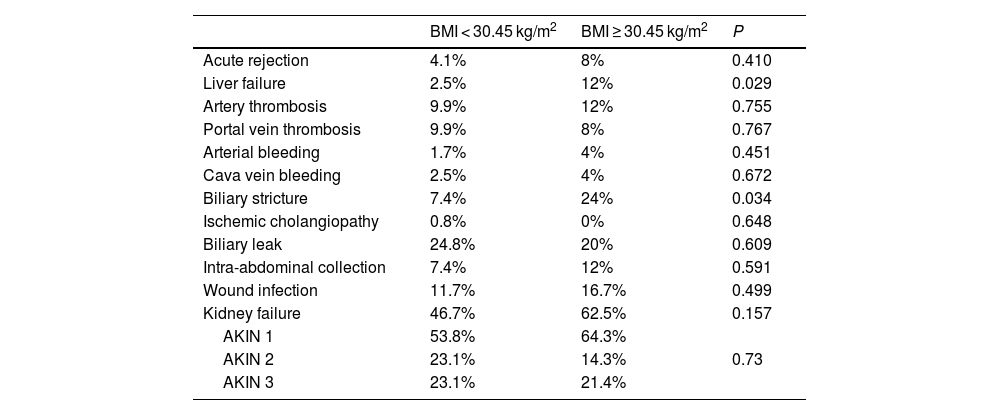Because of the obesity epidemic, more obese patients are on liver transplant (LT) waiting lists. The diseases associated with obesity may increase complications and limit survival after LT. However, there is no established measure or cut-off point to determine this impact and aid decision making. The aim of the present study is to evaluate obesity in patients undergoing LT via BMI and CT-based measurement of adipose tissue (AAT). These parameters will be used to predict the risk of postoperative complications and 5-year survival.
MethodsA retrospective, single-center study was carried out at a tertiary Spanish hospital, including all patients who received LT between January 2012 and July 2019 (n = 164).
The patients were adults who underwent LT using the ‘piggyback’ technique, preserving the recipient vena cava. Visceral adipose tissue (VAT) and BMI were calculated to examine correlations with postoperative complications and 5-year survival.
ResultsNo significant association was found between postoperative complications by Comprehensive Complication Index, BMI, AAT/height, subcutaneous fat/height and VAT/height.
Kaplan-Meier curves for 5-year survival compared LT recipients with BMI < 30.45 versus ≥30.45, with an estimated survival of 58.97 months versus 43.11 months, respectively (P < .001) (Fig. 3) and for LT recipients with an AAT/height <27.35 mm versus ≥27.35 mm, with an estimated survival of 57.69 months versus 46.34 months (P = .001).
ConclusionsThis study does not show a higher rate of postoperative complications in obese patients. There is a significantly lower long-term survival in patients with AAT/height ≥27.35 mm and BMI ≥ 30.45. BMI is a valid estimate of obesity and is predictive of survival.
El aumento de la obesidad en listas de espera para trasplantes de hígado (TH) puede aumentar las complicaciones y limitar su supervivencia. Sin embargo, no existe un punto de corte establecido para su medición y tomar decisiones. El objetivo del estudio es evaluar la obesidad en pacientes sometidos a TH mediante IMC y tejido adiposo abdominal (AAT) en TC. Estos parámetros se utilizarán para predecir el riesgo de complicaciones posoperatorias y la supervivencia a 5 años.
MétodosEstudio unicéntrico retrospectivo en hospital español de nivel terciario, incluyendo los pacientes que recibieron un TH entre enero de 2012 y julio de 2019 (n = 164). Los pacientes eran adultos a los que se les realizó un TH mediante la técnica “piggyback”. Se calcularon el tejido adiposo visceral (VAT) y el IMC para valorar las complicaciones posoperatorias y la supervivencia a 5 años.
ResultadosNo se encontró asociación significativa entre las complicaciones postoperatorias mediante el Índice Integral de Complicaciones con IMC, AAT/talla, grasa subcutánea/talla y VAT/talla. Las curvas Kaplan-Meier a 5 años entre receptores con un IMC < 30,45 frente a ≥30,45, estimaron una supervivencia de 58,97 frente a 43,11 meses (p < 0,001) y para los receptores con un AAT/talla <27,35 mm versus ≥27,35 mm, con una supervivencia estimada de 57,69 versus 46,34 meses (p = 0,001).
ConclusionesEste estudio no muestra una mayor tasa de complicaciones postoperatorias en pacientes obesos. Hay una supervivencia a largo plazo significativamente menor en pacientes con AAT/altura ≥27,35 mm e IMC ≥ 30,45. El IMC estima correctamente la obesidad y predice la supervivencia.















